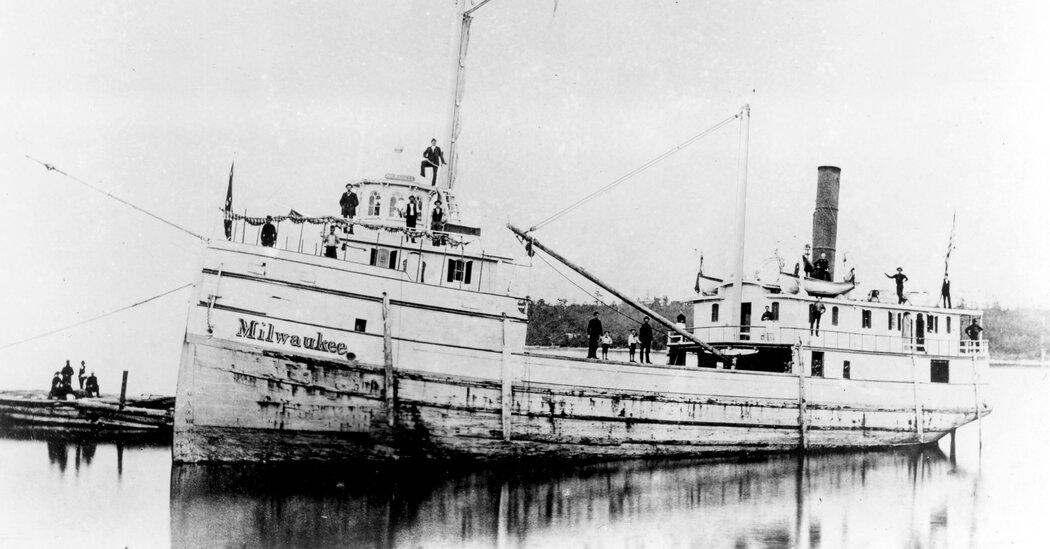On July 9, 1868, the steamship Milwaukee was crossing Lake Michigan on its way to the lakefront town of Muskegon, Mich., to pick up a load of lumber when disaster struck.
It was close to midnight. The water was calm, but smoke was blowing on the surface as a result of wildfires in nearby Wisconsin. The Milwaukee steered toward a similar lumber ship, the C. Hickox, which was headed for Chicago.
Suddenly a thick fog rolled in. The Hickox crashed into the side of the Milwaukee. Hours later, the Milwaukee plunged to the bottom of Lake Michigan.
It lay there undiscovered until last June, when a team of researchers from the Michigan Shipwreck Research Association discovered the shipwreck, using news clippings from the time, historical weather data and remote sensing equipment to clue them to its location. They then spent the summer filming the wreckage. The researchers announced the discovery on Saturday.
The Milwaukee is one of an estimated 6,000 to 10,000 shipwrecks in the Great Lakes, Valerie van Heest, the association’s director, said in an interview. About 2,000 have been discovered.
A team led by Ms. van Heest and her husband, Jack van Heest, learned about the sinking of the Milwaukee by consulting a database of missing ships compiled by regional historians.
“To make a discovery is to learn something about these missing ships and then to share it with the public,” Ms. van Heest said. “And largely, it’s a reminder of how the Great Lakes region was developed and settled.”
To locate the Milwaukee, Ms. van Heest’s team found contemporaneous newspaper accounts of its sinking, including in The Chicago Tribune, The Chicago Daily News, The Muskegon Chronicle and The Inner Ocean, which reported on shipping accidents in the Great Lakes.
From the news clippings, Ms. van Heest and other researchers were able to determine the ship’s course and a description of where the crash happened from accounts given by its captain.
Those reports also offered a harrowing account of what happened to the Milwaukee.
Dennis Harrington, the lookout on the Milwaukee, was the first to spot the lights from the Hickox, and notified the Milwaukee’s captain right away. Standard operating procedures would have called for both ships to slow down, steer to starboard and blow their steam whistles. But the captains of both ships, thinking the visibility was fine, did not do any of those things.
Then the thick fog arrived, and by the time it dissipated, it was too late for either ship to turn. The Hickox thrust into the Milwaukee, sending Harrington overboard. He would be the accident’s lone casualty.
Pandemonium erupted aboard the Milwaukee, according to the shipwreck research association, as the captain went below deck to see that the ship was taking on water. He blew a distress signal to alert the Hickox, and the crew stretched a canvas sail over the damaged side of the ship to slow the rush of lake water.
In the course of their research, the team discovered that at least one other ship, a steamer called The City of New York, came to try to save the Milwaukee. It teamed up with the Hickox, sandwiching the Milwaukee between them. The crews of both ships used ropes in a vain attempt to try to keep the Milwaukee afloat.
Almost two hours after impact, the Milwaukee’s stern dipped below the surface, and the ship sank to the bottom of the lake. Aside from Harrington, everyone aboard the doomed vessel made it to safety aboard the Hickox, which carried both crews to Chicago.
Using historical weather data, the researchers were able to nail down a more precise location for the Milwaukee. Searching the lake floor with a remote-operated vehicle, the researchers found the ship “remarkably intact,” the Michigan Shipwreck Research Association said in its statement.
Before it sank, the Milwaukee had been running for almost two decades. It was commissioned in 1868 by the Northern Transportation Company of Ohio to ferry passengers and goods. It was originally 135 feet long and featured two decks — one for passengers and one for goods. In 1881, it was sold and remodeled so it could carry more goods and fewer passengers.
Two years later, Lyman Gates Mason bought the Milwaukee to haul his company’s lumber to Chicago. In the video collected from the remote vehicle, researchers discovered something: Mr. Mason had remodeled the ship. In shrinking the aft cabin and the pilothouse, Mr. Mason made more room for cargo and remade the vessel into something that looked very different from the lone surviving photo of the Milwaukee.
This was the Michigan Shipwreck Research Association’s 19th discovery since it was founded about two decades ago.
Ms. van Heest, who is also a museum exhibit designer, said that it took two days to find the Milwaukee and that it was “the fastest discovery we’ve made.” Sometimes, she said, searches can take years depending on how calm the water is and how far offshore the team must travel.
Even though the Milwaukee itself is a fairly ordinary ship for its time, Ms. van Heest said that the wreck was an indication of how dependent the Great Lakes region was on lumber at the time.
“These are, so to speak, museum artifacts sitting at the bottom of the lake that have stories to tell,” she said.












